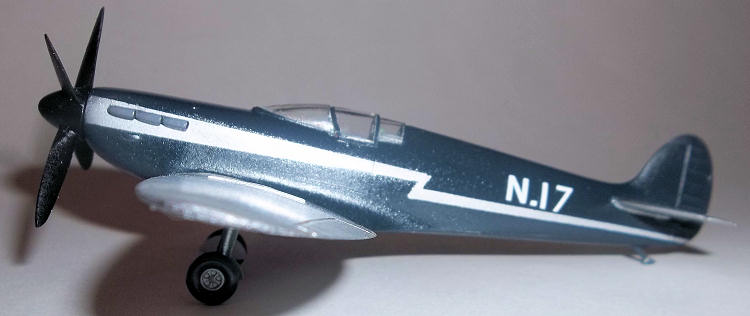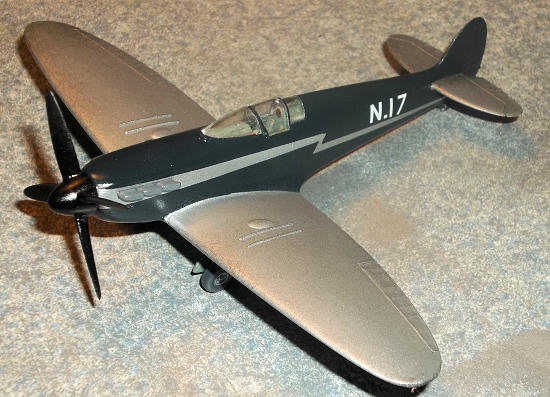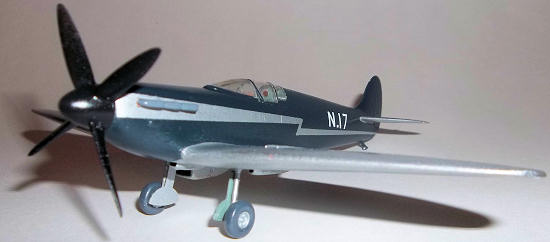Hasegawa
1/72 “Speed Spitfire”
|
KIT #: |
A15 |
|
PRICE: |
$ |
|
DECALS: |
Two Options |
|
REVIEWER: |
Brian Baker |
|
NOTES: |
Simple
conversion |

The
“Speed Spitfire” was a project designed to capture the world speed record just
before the outbreak of World War II.
A standard production Spitfire Mk. I, K9834, was taken from the
production line and rebuilt by the Supermarine company in order to make the
plane competitive with the Messerschmitt and Heinkel contenders.
When the Messerschmitt Bf-209-V1 broke the World’s Speed Record with a
speed of 469 mph. in 1939, Supermarine abandoned their attempt, and the plane
was later modified for other uses.
 A number
of sources provide photos of this aircraft in various stages of its career.
The Dulcimus “Supermarine Spitfire” book by Peter Moss has some good
photos on pp. 20-21, while the old Harleyford “Spitfire-The Story of a Famous
Fighter” by Bruce Robertson is also useful, with photos on p. 154. Both sources
have good text coverage. The old Profile No. 41, “Spitfire I & II”,by Philip
J.R. Moyes, also has photos and a color drawing, but they portray the colors
wrong, as the trim was silver, not yellow, and the wings and horizontal
tailplane were silver, not blue as the Profile indicates. However, a case could
be made for painting the tops of the wings dark blue, although a rear view of
the airplane is not available.
A number
of sources provide photos of this aircraft in various stages of its career.
The Dulcimus “Supermarine Spitfire” book by Peter Moss has some good
photos on pp. 20-21, while the old Harleyford “Spitfire-The Story of a Famous
Fighter” by Bruce Robertson is also useful, with photos on p. 154. Both sources
have good text coverage. The old Profile No. 41, “Spitfire I & II”,by Philip
J.R. Moyes, also has photos and a color drawing, but they portray the colors
wrong, as the trim was silver, not yellow, and the wings and horizontal
tailplane were silver, not blue as the Profile indicates. However, a case could
be made for painting the tops of the wings dark blue, although a rear view of
the airplane is not available.
Building a model of the “Speed Spitfire” should present few
challenges for the experienced modeler.
Although the Airfix kit would be just as appropriate, I selected the
Hasegawa kit, mainly because it had the flat canopy that would require only the
windshield portion to be replaced, and it is a very simple, basic kit.
A number of changes needed to be made, including the following:
1.
Replace
windscreen with a new part, preferably vacuformed, although any suitable form
from the spares box will work if properly shaped.
2.
Engine is
now 2,160 hp. Merlin
IIIM,
not externally visible.
3.
Enlarged
radiator on right side. This will require replacement.
4.
Wooden
fixed pitch four bladed prop.
Spares box should have this. I used old Airfix P-51D prop, suitably reshaped,
and the blades are quite sharp and tapered.
 5.
Wings
need to be shortened slightly, from 36’-10” span to 33’-8” span, or 13” each
side. This can be done by merely sanding them down—the wing shape is only
slightly more blunt than the standard elliptical wing.
5.
Wings
need to be shortened slightly, from 36’-10” span to 33’-8” span, or 13” each
side. This can be done by merely sanding them down—the wing shape is only
slightly more blunt than the standard elliptical wing.
6.
Remove
all armament, ejector chutes, etc. Don’t install the gunsight.
7.
Remove
the tailwheel and replace with a tailskid. This was done by cutting the
tailwheel off and using the strut and wheel housing for the leg and skid.
The tailwheel strut is quite robust, and
converts to a tailskid easily. A
no-brainer.
8.
Remove
any rivets, as plane was flush riveted.
9.
Remove
the radio antenna mast. Later a VHF
whip was installed.
10. Remove the upper wing reinforcement strakes. Ed
Otherwise,
the airplane is basically a standard production Spitfire.
It was painted what is described
as a glossy Supermarine Blue overall with a silver cheat line. I used glossy
US
Navy
Sea
Blue, and it looks convincing enough, although it probably isn’t quite the right
shade. (All photos are in black and white).Originally, the prop and spinner were
silver, with black rear prop surfaces for anti-glare.
According to photos, the prop was later painted entirely black.
If you are going to model the airplane later in its career, the
windshield was shortened to normal size, still without framing, as the P.R.
marks had, and the plane was then
painted PRU Blue with a red trim line along the fuselage side, as shown in a
photo taken in 1946. By this time, the plane was the personal aircraft of
Air Commodore J.R. Boothman, who had flown one of the Supermarine S-6
floatplanes in the Schneider Trophy Races, and by this time it had been equipped
with a normal Mk. V style radiator and a standard Rotol 3 bladed prop such as
used by many Mk. V’s.
During
the war years, the plane was converted to a P.R. Mk.
III
standard and used by the Photographic Reconnaissance Unit at Heston.
Presumably the aircraft was painted PRU blue overall while it operated in
this role, although I can find no references or photos to substantiate this.
After its retirement from P.R. work, it served as A.C. Boothman’s
personal aircraft until the end of the war, after which it was scrapped.
No information provided.
The
kit can be built almost straight from the box, omitting the propeller.
The radiator housing needs to be removed, and I did this with a
razor saw, and it came off smoothly without any damage to the wing
undersurface. I looked around in my
spares box for a suitable shaped piece of plastic, and came up with part of the
fuselage nose section from an old Revell Fokker D.VII
that I had scrapped many years ago. I cut it down to shape and size,
added the radiator faces, and glued them together.
Painting
is a snap, as the silver goes on first.
After some masking, the blue can be applied.
The only decals required are the “N.17” on the rear fuselage sides.
I used white, although the color could have been silver.
From the intensity of the colors, and after careful examination of all
the available black and white photos, I thought white would have been the more
likely color.
 The
result is a model that stands out in a collection of Spitfires, especially since
it is so colorful compared with the usual camouflaged examples.
It was a lot of fun, one of those quick conversions that adds a
historically significant airplane to my collection without requiring a lot of
extra effort. The old Hasegawa kit worked out very well, although you could
probably use an Airfix Mk. I or any of the other Mk. I’s that are available.
Just be sure to use the flat canopy, as all Mk. I kits do not supply this.
The
result is a model that stands out in a collection of Spitfires, especially since
it is so colorful compared with the usual camouflaged examples.
It was a lot of fun, one of those quick conversions that adds a
historically significant airplane to my collection without requiring a lot of
extra effort. The old Hasegawa kit worked out very well, although you could
probably use an Airfix Mk. I or any of the other Mk. I’s that are available.
Just be sure to use the flat canopy, as all Mk. I kits do not supply this.
Brian
Baker
August 2012
Copyright ModelingMadness.com. All rights reserved. No reproduction in any form without express permission from the editor.
If you would like your product reviewed fairly and fairly quickly , please
contact
the editor or see other details in the
Note to
Contributors.
Back to the Main Page
Back to the Review
Index Page 2025
5.
Wings
need to be shortened slightly, from 36’-10” span to 33’-8” span, or 13” each
side. This can be done by merely sanding them down—the wing shape is only
slightly more blunt than the standard elliptical wing.